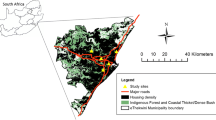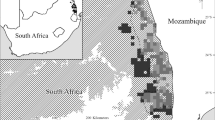Abstract
Surprisingly few studies have considered the extent to which the nature of the ownership of land is associated with differences in biodiversity. We analysed ownership and other landscape-level effects on rare-species richness for both globally- and regionally-rare biota (including birds, herpetofauna, butterflies, mammals, and plants) in 289 designated natural areas (NAs) in southern Ontario, Canada. Information about each NA −including area, number of plant communities, ownership status and details of species diversity were collected from published sources. Length of perimeter of NA, relative isolation, and an estimate of fragmentation were measured using image analysis and GIS techniques. NAs were in general relatively small, with mean area of 158 ha (median 85 ha, range from 0.9 to 1278 ha) for private NAs; public NAs had mean area of 132 ha (median 16 ha, range from 0.1 to 1481 ha). Mean number of plant communities was 4.6 (median 4, range 1- 13) at private NAs and 3.8 (median 3, range 1-16) at public NAs. Our results show that, of several landscape-level factors, area had the greatest effects on rare-species richness and other biotic indices. Effects of area were followed by effects of plant community diversity, however this was itself significantly affected by area and the extent of perimeter of the NA. Both these factors were followed by effects of ownership of the NA and by effects of isolation of the NA (represented by minimum distance to nearest NA and by number of NAs in 10 km radius). Other landscape- level factors did not appear to have overall significant effects. Variation in area accounted for 0.1% to 29% of variation in number of rare species, with lower values for globally-rare, than for regionally-rare taxa. For all biotic groups, public ownership of NAs was associated with significantly greater rare-species richness compared to private ownership, even after other factors such as area were controlled. For all globally-rare biota except butterflies, area of NA had greater effects on rare-species richness than did ownership. Richness of regionally- rare birds was more affected by plant community diversity than by area of NA. Number of recorded plant communities accounted from 2.1% of variation in number of globally-rare plant species to as high as 31% of variation in regionally-rare butterflies. The diversity of plant communities was itself influenced by total site area (accounting for 45% of variation), extent of elongation of the NA, and both external- and interior- edge perimeters. Public NAs had greatest numbers of rare biota and so should be a significant focus for conservation programs. Smaller, privately-owned patches of natural area dominate (by number and area) in this densely populated region and their significance should not be overlooked.
Similar content being viewed by others
References
Adger W.N. and Luttrell C. 2000. The values of wetlands: land scape and institutional perspective. Ecological Economics 35: 75-89.
Allen G.M., Eagles P.F.J. and Price S.D. (eds), 1990. Conserving Carolinian Canada: conservation biology in the Deciduous For est Region. University of Waterloo Press, Waterloo, Ontario, Canada.
Brownell V.R. and Blaney C.S. 1995. Lower Trent Region natural areas-Volumes 1 & 2: A biological inventory and evaluation of 38 natural areas in the Lower Trent Region, 1994. Lower Trent Region Conservation Authority, Trenton, Ontario, Canada.
Burke D.M. and Nol E. 2000. Landscape and fragment size effects on reproductive success of forest-breeding birds in Ontario. Ecological Applications 10: 1749–1761.
Cairns J. and Bidwell J. 1996. Discontinuities in technological and natural systems caused by exotic species. Biodiversity and Con servation 5: 1085–1094.
Costanza R., d'Arge R., de Groot R., Farber S., Grasso M., Han non B., Limburg K., Naeem S., O'Neill R., Paruelo J., Raskin R., Sutton P. and van den Belt M. 1997. The value of the world's ecosystem services and natural capital. Nature 387: 253–260.
Craig J.,Anderson S., Clout M., Creese B., Mitchell N., Ogden J., Roberts M. and Usher G. 2000. Conservation issues in New Zealand. Annual Review of Ecology and Systematics 31: 61–78.
Crow T.R., Host G.E. and Mladenoff D. J. 1999. Ownership and ecosystem as sources of spatial heterogeneity in a forested land scape, Wisconsin, USA. Landscape Ecology 14: 449–463.
Daily G. (ed.), 1997. Nature's services: societal dependence on natural ecosystems. Island Press, Washington, DC, USA.
Dale V. H., Brown S., Haeuber R.A., Hobbs N.T., Huntly N., Naiman R.J., Riebsame W.E., Turner M.G. and Valone T.J. 2000. Ecological principles and guidelines for managing the use of land. Ecological Applications 10: 639–670.
Delcourt H.R. and Delcourt P.A. 2000. Eastern deciduous forests. Pages 357–396. In: Barbour M.G. and Billings W.D. (eds), North American terrestrial vegetation, 2nd ed. Cambridge University Press, Cambridge, UK.
Falkner M. and Stohlgren T. 1997. Evaluating the contribution of small national park areas to regional biodiversity. Natural Areas Journal 17: 324–330.
Freemark K.E. and Merriam H.G. 1986. Importance of area and habitat heterogeneity to bird assemblages in temperate forest fragments. Biological Conservation 31: 95–105.
Gobin A., Campling P. and Feyen J. 2001. Spatial analysis of rural land ownership. Landscape and Urban Planning 55: 185–194.
Government of Ontario. 1997. Census statistics for 1996. Queen's Printer for Ontario. Toronto, Ontario, Canada.
Government of Ontario. 2000. Ontario population projections, 1999-2028. Queen's Printer for Ontario. Toronto, Ontario, Canada.
Groves C.R., Kutner L.S., Stoms D.M., Murray M.P., Michael Scott J., Schafale M., Weakley A.S. and Pressey R.L. 2000. Owning up to our responsibilities: who owns lands important for biodiversity? Pages 275–300. In: Stein B.A., Kutner L.S. and Adams J.S. (eds), Precious heritage: the status of biodiversity in the United States. Oxford University Press, New York, New York, USA.
Hale M.L., Lurz P.W., Shirley M.D., Rushton S., Fuller R.M. and Wolff K. 2001. Impact of landscape management on the genetic structure of red squirrel populations. Science 293: 2246–2248.
Heagy A. (ed.), 1993, 1995. Hamilton-Wentworth natural areas in ventory. Volume I, II. Hamilton Conservation Authority, Hamil ton, Ontario, Canada.
Holling C.S. and Meffe G. 1996. Command and control and the pathology of natural resource management. Conservation Biol ogy 10: 328–337.
James A.N., Gaston K.J. and Balmford A. 2000. Why corporate in stitutions alone will not do enough to protect biodiversity. Na ture 404: 120.
Kamstra J., Oldham M.J. and Woodliffe P.A. 1995. A life science inventory and evaluation of six natural areas in the Erie islands, Essex County, Ontario: Fish Point Provincial Nature Reserve, Lighthouse Point Provincial Nature Reserve, Stone Road Com plex, Middle Point, East Sister Island Provincial Nature Reserve, and Middle Island. Ontario Ministry of Natural Resources, Ay lmer, Ontario, Canada.
Keitt T.H., Urban D.L. and Milne B.T. 1997. Detecting critical scales in fragmented landscapes. Conservation Ecology [online] 1: 4. Available at URL: http://www.consecol.org/vol1/iss1/ art4.
Kindscher K. and Scott N. 1997. Land ownership and tenure of the largest land parcels in the Flint Hills of Kansas, USA. Natural Areas Journal 17: 131–135.
Larson B.M., Riley J.L., Snell E.A. and Godschalk H.G. 1999. The woodland heritage of southern Ontario. Federation of Ontario Naturalists, Toronto, Ontario, Canada.
Lee H., Bakowsky W., Riley J., Bowles J., Puddister M., Uhlig P. and McMurray S. 1998. Ecological land classification for south ern Ontario: first approximation and its application. Ontario Ministry of Natural Resources, Southcentral Science Section, Science Development and Transfer Branch, Toronto, Ontario, Canada.
Lovett-Doust J. and Kuntz K. 2001. Land ownership and other landscape-level effects on biodiversity in southern Ontario's Niagara Escarpment Biosphere Reserve. Landscape Ecology 16: 743–755
MacArthur R. and Wilson E.O. 1967. The theory of island bioge ography. Princeton University Press, Princeton, New Jersey, USA.
Master L.L. 1991. Assessing threats and setting priorities for con servation. Conservation Biology 5: 559–563.
Metropolitan Toronto and Region Conservation Authority. 1982 (plus updates of 1994, 1995, and 1996). Environmentally signif icant areas study. Toronto, Ontario, Canada.
Newmaster S.G., Lehela A., Uhlig P., McMurray S. and Oldham M.J. 1998. Ontario plant list. Ontario Forest Research Institute, Sault Ste Marie, Ontario, Canada.
Natural Heritage Information Centre (NHIC). 1999. Lists of On tario species. Ontario Ministry of Natural Resources, Peterbor ough, Ontario, Canada. Available at URL: http://www.mnr.gov.on.ca/MNR/nhic/queries/lists.html
Oldham M.J. 1983. Environmentally significant areas of the Essex Region: a background report to the Essex Region Conservation Plan. Updated in 1991. Essex Region Conservation Authority, Essex, Ontario, Canada.
Pearce C. 1993. Coping with forest fragmentation in southern On tario. Pages 100–113. In: Poser S., Crins W. and Beechy T. (eds), Size and integrity standards for natural heritage areas in Ontario. Parks and Natural Heritage Policy Branch, Ontario Ministry of Natural Resources, Toronto, Ontario, Canada.
Pimm S.L., Russell G.J., Gittleman J.L. and Brooks T.M. 1995. The future of biodiversity. Science 269: 347–350.
Platt R.H. 1996. Land use and society. Island Press, Washington, DC, USA.
Ramsey R. 1988. Information Bulletin: Ontario Land Registry Of fice Records; Archives of Ontario. Toronto, Ontario, Canada.
Ricketts T.H., Dinerstein E., Olson D.M., Loucks C.J., Eichbaum W., DellaSala D., Kavanagh K., Hedao P., Hurley P.T., Carney K.M., Abell R. and Watters S. 1999. Terrestrial Ecoregions of North America. Island Press, Washington, DC
Riley J.L., Jalava J.V. and Varga S. 1996. Ecological Survey of the Niagara Escarpment Biosphere Reserve. Volume I. Significant Natural Areas. Volume II. Technical Appendices. Ontario Min istry of Natural Resources, Southcentral Region, Peterborough, Ontario, Canada.
Sala O.E., Chapin III F.S., Armesto J.J., Berlow E., Bloomfield J., Dirzo R., Huber-Sanwald E., Huenneke L.F., Jackson R., Kinzig A., Leemans R., Lodge D., Mooney H.A., Osterheld M., Poff N.L., Sykes M.T., Walker B.H., Walker M. and Wall D.H. 2000. Global biodiversity scenarios for the year 2100. Science 287: 1770–1776.
Spies T.A., Ripple W.A. and Bradshaw G.A. 1994. Dynamics and pattern of a managed coniferous forest landscape in Oregon. Ecological Applications 4: 555–568.
Stein B.A., Breden T. and Warner R. 1995. Signficance of federal lands for endangered species. Pages 389–401 In: LaRoe E.T. (ed.), Our living resources. Department of Interior, National Biological Service, Washington, DC, USA.
Theberge J.B. 1989. Legacy: the natural history of Ontario. Mc Clelland & Stewart Inc., Toronto, Ontario, Canada.
Thomas R., Kirby K.J. and Reid C. 1997. The conservation of a fragmented ecosystem within a cultural landscape: the case of ancient woodland in England. Biological Conservation 82: 243–252.
U. S. Government Accounting Office (USGAO). 1995. Endangered species act: information on species protection on non-federal lands. GAO/RCED-95-16. USGAO, Washington, DC, USA.
Vitousek P.M., Mooney H.A., Lubchenco J. and Melillo J.M. 1997. Human domination of Earth's ecosystems. Science 277: 494–499.
Wilson E. 1992. The diversity of life. The Belknap Press of Har vard University Press, Cambridge, MA, USA.
Wright R.G., Scott J.M., Mann S. and Murray M. 2001. Identify ing unprotected and potentially at risk plant communities in the western USA. Biological Conservation 98: 97–106.
White D., Minotti P.G., Barczak M.J., Sifneos J.C., Freemark K.A., Santelmann M.V., Steinitz C.F., Kiester A.R. and Preston E.M. 1996. Assessing risks to biodiversity from future landscape change. Conservation Biology 11: 349–360.
Zar J. 1999. Biostatistical analysis. Prentice-Hall, Englewood Cliffs, New Jersey, USA.
Author information
Authors and Affiliations
Rights and permissions
About this article
Cite this article
Lovett-Doust, J., Biernacki, M., Page, R. et al. Effects of land ownership and landscape-level factors on rare-species richness in natural areas of southern Ontario, Canada. Landscape Ecology 18, 621–633 (2003). https://doi.org/10.1023/A:1026028017696
Issue Date:
DOI: https://doi.org/10.1023/A:1026028017696




